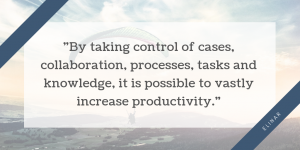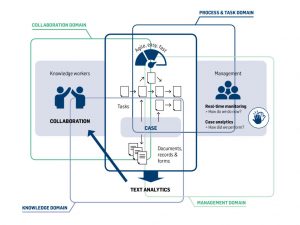Organizations have entered the world of cognitive work and workers. Whether we talk about government, intelligence, law enforcement or some other organization the cognitive era is here. But to manage this old process automation solutions are outdated. Enterprise Content Management – and especially Case Management – is suitable for this era. Let us explain why.
Old process automation approach is no longer viable, as processes are more people-driven descriptions have evolved. Also they are continually evolving. Workers need new skills to complete complex tasks with fewer resources.
“As workflow and business process management (BPM) become outdated and increasingly ineffective for less-structured work patterns, providers that offer improved analytics and information modeling will emerge as leaders.” – Le Clair, C. (2016, February). The Forrester Wave™: Dynamic Case Management, Forrester.
You need to minimize costs and risks while remaining efficient. Naturally, you must also obey many laws and regulations.
Enter case management
An era of knowledge workers calls for adequate tools, which enable autonomous decision-making and effective collaboration. Luckily, case management makes this possible.
Case management is a semi-structured, but also collaborative, dynamic and information-intensive process. Outside events are driving it. It requires incremental and also progressive responses from the business domain handling the case.
Examples of case folders include a patient record, a lawsuit, an insurance claim, or a contract. The case folder would include all the documents, data, collaboration artifacts, policies, rules, analytics, and other information what you need to process and manage the case. By taking control of cases, collaboration, processes, tasks and knowledge, it is possible to vastly increase productivity.
How we can help you?
Elinar provides services based on IBM Case Manager (ICM) and other enterprise content management solutions. We recognize content management challenges in four areas, which are: 1) Collaboration Domain, 2) Process & Task Domain, 3) Knowledge Domain and 4) Management & Optimization Domain.
You can manage each domain itself, however, a business process often manages multiple of the four domains. It is no longer a matter of managing the business process using traditional transactional Business Process Management (BPM) or through Enterprise Resource Planning (ERP) but managing all four domains concurrently.
1) Collaboration Domain
Challenges
- Reluctance: Many knowledge workers are reluctant to collaborate
- Waste of time: Significant amount of time is spent on collaborating with peers
- Availability: You need to get all project data available immediately as much everyone involved reachable
- External collaboration tools do not integrate seamlessly into business processes
Benefits of Case Management at Collaboration Domain
- ICM enables collaboration integration into the business process
- All parties involved with a case can collaborate in various roles and levels of involvement
- Add IBM Connections for enterprise-wide collaboration and expertise mining
2) Process & Task Domain
Challenges
- IT involvement: Corporation can not typically manage BPM Processes but requires heavy IT involvement upon definition & change
- Modeling knowledge worker tasks will make BPM processes intricate and inflexible
- Traditional BPM is not well suited for document-centric task-based workloads
- Issues with Ad Hoc processes which are processes and tasks that knowledge workers will start as needed
- Traditional BPM processes will start and run to completion
Benefits of Case Management at Process & Task Domain
- Business Self Service on workflow definition and management – Business can change knowledge worker processes and tasks rapidly
- A working model is knowledge worker-centric and not process-centric – For tasks that are knowledge worker-based, this is a supreme way of defining work and related material
- A comprehensive solution for case-based workloads
- Intuitively collects tasks, process fragments, and documents underneath a persistent case
- Embedded business rules engine for modeling business rules which you can manage independently
3) Knowledge Domain
Challenges
- Complex knowledge workers spend a significant amount of time locating relevant knowledge:
- What do we know about the matter?
- How other have resolved similar issues?
- Who was involved?
- How is our business environment changing?
- Why are our customers leaving us?
Benefits of Case Management at Knowledge Domain
- Advanced text analytics capabilities to mine abstract knowledge and changes in the business environment
- In-depth knowledge about similar matters instantly
4) Management Domain
Challenges
- Managing knowledge workers can be a challenge as work is often quite chaotic
- Visibility of workloads and performance metrics can be difficult to obtain
- Optimization: Many knowledge workers are smart, but not working optimally
Benefits of Case Management at Management Domain
- Analyzes: Enables managers to analyze performance and increase productivity
- Decreases the management tracking and reporting, through integrated analysis and reporting features
- Monitoring: Ready-to-use real time monitoring capability
More than 1,300 government customers in over 80 countries use IBM ECM solutions to promote operational efficiency, reduce costs, improve service, and foster collaboration between departments, agencies, and the public.
The solutions help organizations access and manage content (regardless of how it was created and where it resides), streamline and automate their processes. Also, it helps share information across agencies and with constituents.







